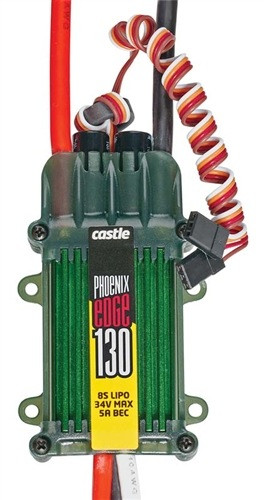
- REVIEWS
- QUESTIONS

This is the Castle Creations Phoenix Edge 100-Amp 34-Volt Electronic Speed Control with 5-amp BEC. The Phoenix Edge 100 is intended for use in helicopters ranging from 500 to 600 size, and fixed wing aircraft from .40-.90 size. As always, the Edge series of controllers offer industry-leading software functions, data logging, and USB programming capability via Castle Link USB adapter (free with included coupon).
With the debut of the Phoenix Edge series of ESCs, the next evolution in speed controller technology has arrived. The Edge series introduces a user programmable auxiliary wire capable of functions modelers have only dreamed of, until now. The white auxiliary wire can be used for helicopter governor gain input adjustments mid-flight, serve as an audible beacon after an unexpected landing, act as an RPM output for 3-axis gyros that support RPM sensors, be used as an ESC arming lock (coupon for free Arming Lockout Key included) or as a receiver arming lock. Combined with the data logging capability the Edge series of controllers offer, users can enjoy unparalleled versatility.
Includes: Phoenix Edge 100 Amp 34V ESC with Instruction Sheet
Requires: Battery and motor connectors of modeler's choice
Input Voltage: 2S-8S LiPo
Max Continuous Amps at Full Throttle: 100A
BEC Output: 5-amp peak**
Dimensions: 2.0 x 2.8 x 0.9" (50.8 x 71.9 x 23.2mm)
Weight: 4.5oz (126.6g) with wires 2.6oz (72.9g) without wires
*RC HOBBY APPLICATION RATING: 100 amps for the duration of a single 5,000 mAh battery pack with the ESC in contact with a 5 mph airflow of 25C (77F) or cooler air. Controller temperature must never exceed 100C (212F). Exceeding current or temperature ratings may damage components and may shorten the life of the ESC. Always verify system current draw at full-throttle. Decrease load or increase airflow to decrease the ESC's operating temperature.
**Peak indicates amperage sustainable for 0.5 seconds - long enough for most servos current draw transients. Your setup may vary. Always confirm servo current draw before the first flight of the model.





